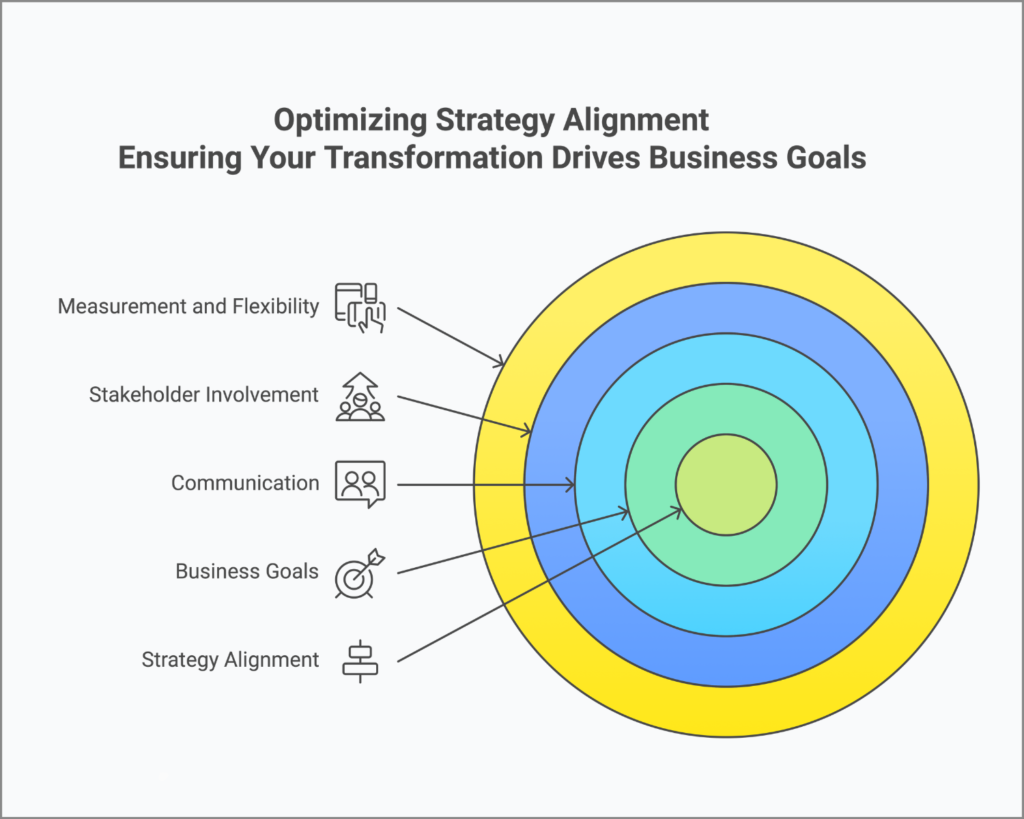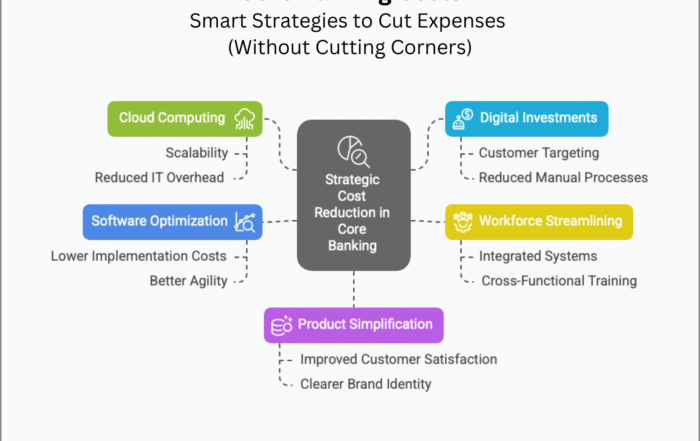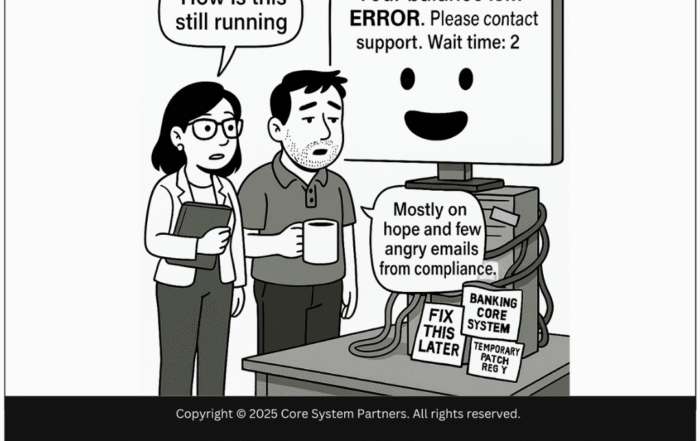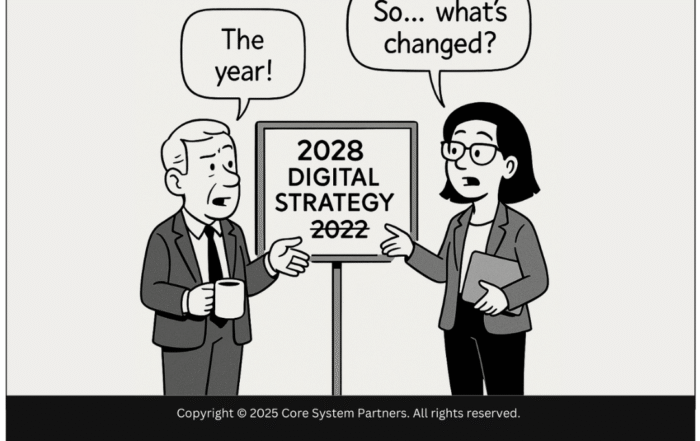
Optimizing strategy alignment ensures your core banking transformation drives meaningful business outcomes, maximizing impact and resource efficiency.
The article “Optimizing Strategy Alignment: Ensuring Your Transformation Drives Business Goals” discusses how organizations can effectively align their strategic initiatives with overarching business objectives to achieve successful transformations.
TL;DR – Optimizing Strategy Alignment: Ensuring Your Transformation Drives Business Goals
- Assess Organizational Structure – Evaluate and adjust your organization’s framework to support strategic objectives.
- Allocate Resources Wisely – Ensure that resources are distributed in a manner that aligns with strategic priorities.
- Foster a Supportive Culture – Cultivate an organizational culture that embraces and supports strategic initiatives.
- Monitor and Adjust Strategies – Continuously track the effectiveness of strategies and make necessary adjustments to stay aligned with business goals.
By focusing on these areas, organizations can enhance their strategic alignment, leading to more effective transformations and the achievement of business objectives.
Have you ever invested much time and energy into something only to find that it has yet to help your organization reach its goals?
This happened to one of the leading regional banks, which had executed new technologies during the core banking transformation and needed to get the expected outcome. Why? Because the bank’s transformation initiatives were not directed toward its strategic objectives.
Strategy alignment is a compass guiding your transformation efforts toward meaningful outcomes. Without it, even the most carefully carried out projects can miss the mark or fail. In this article, we’ll discuss the importance of aligning your core banking transformation with your business strategy and provide practical advice to ensure your initiatives move in the right direction.
Understanding Strategy Alignment
So, what is strategy alignment? It means all the transformation initiatives taken, processes changed, and new technology introduced should help achieve the organization’s long-term goals. It’s connecting your high-level strategic objectives with your day-to-day operations.
Why Is It Important?
Consider this: Your organization is like a ship. Business strategy is its destination and transformation initiatives its journey; without alignment, you might find yourself:
- Waste of Resources: Time, money, and talent could have been better spent on projects that do not align with the strategic objectives.
- Fragmenting Efforts: Teams can fall into silos, pursuing conflicting objectives.
- Lost Opportunities: Not using transformation for strategic competitive advantage can mean lost market share or revenue.
But when strategy alignment is achieved:
- Unified Direction: Movement by everyone towards common goals.
- Economy: You don’t squander resources but spend your money more wisely.
- Tangible Impact: Business outcome-focused transformation efforts.
Critical Components of Strategy Alignment
Tie the following key areas together to ensure that the transformation aligns with your business strategy:
1. Alignment with Business Goals
Align every transformation initiative to the strategic mission of your organization.
- Make Strategic Priorities: Make clear what shall be reached in an organization, whether short or long.
- Map Initiatives to Goals: Map every project or change to these priorities.
- Evaluate Impact: Assess frequently how initiatives contribute to business outcomes.
2. Communication of Strategic Objectives
Communication also greatly helps everyone understand the “why” of the change that needs to be instituted.
- Messaging transparency: Messaging of the strategic imperatives to the stakeholders.
- Contextualize changes: Explain how specific initiatives contribute to larger objectives.
- Reinforce Regularly: Keep strategic goals top-of-mind through consistent communication.
3. Stakeholder Involvement Regarding Strategic Planning
Early involvement fosters ownership and consensus among the key stakeholders.
- Collaborative Planning: Leaders and team members from different departments engage in planning.
- Diverse Perspectives Leverage: diversity of functional insights in developing more tangible strategies.
- Consensus Building: This means a shared ownership of the vision and objectives.
4. Measurement and Tracking of Alignment
If you can’t measure it, then there is no way that you can manage it.
- Define Metrics: Indicators of performance are primary measures reflecting relevant strategic objectives.
- Regular Reporting: Progress monitoring and reporting to the stakeholders.
- Adjust as Needed: Be prepared to pivot if initiatives aren’t delivering the expected impact.
5. Flexibility to Adapt Strategy
Business is always set and remembered; your strategy should be separate.
- Market Trend Following: Stay updated on industry trends, customer needs, and competitors’ moves.
- Be Agile: Plans and programs need to adjust to new information.
- Continuous Learning: Encourage the culture of learning fast and quick adaptation.
Best Practices for Achieving Strategy Alignment
How would you align your change initiatives with the business strategy? Well, here are some actionable best practices:
1.Develop a Clear Strategic Roadmap
- Visualize the Route: Map out how to reach the strategic goals, identifying activities, timelines, and milestones.
- Comprehensive Communication: Transparency in the roadmap throughout the organization.
2. Engage in Strategic Workshops
- Facilitate Collaboration: Provide workshops regarding strategies and strategic objectives, including how the transformational initiatives support them.
- Break Down Silos: Interdepartmental communications will align the functions.
3. Establish Governance Structures
- Create Oversight Committees: Each committee must align the strategy and transformation.
- Define Decision-Making Processes: Decisions are made through which route and by whom.
4. Use Strategic Alignment Tools
- Balanced Scorecards: A design tool that connects performance measures to the strategic objects.
- Alignment Software: Leverage technology in the process of tracking alignment.
5. Foster a Culture of Alignment
- Align Incentives: Ensure that performance reviews and incentives match strategic goals.
- Promote Strategic Thinking: Enable staff at every level to see how their efforts fit the big picture.
The Impact on Transformation Success
When your change is lined up with your strategy, the payoffs are enormous:
- Increased ROI: Spending on Transformation offers measurable returns.
- Improved Focus: Teams work cohesively toward shared objectives.
- Enhanced Agility: The organization can respond more effectively to changes in the market.
- Sustainable Growth: Alignment supports long-term success rather than short-term wins.
Failing to achieve alignment, on the other hand, can lead to:
- Wasted Resources: Efforts may not contribute to strategic goals, resulting in lost time and money.
- Employee Disengagement: Teams may become frustrated if they need to see how their work matters.
- Strategic Drift: The organization may veer off course, missing critical opportunities.
A Story of Alignment
Remember that regional bank? Realizing this misalignment, they stepped back to reconsider much of the activity that was taking place. By redefining what they were trying to achieve strategically—including stakeholder involvement throughout the organization—they mapped their change initiatives against those objectives. Communication went up; the teams understood where their effort fit in, and refreshing was the transformation that came along with modernizing their systems to bring in a severe rise in customer acquisition and satisfaction.
Moving Forward
Strategy alignment isn’t a one-time task—it’s an ongoing commitment to ensuring that every effort propels your organization toward its goals. By focusing on alignment, you’re not just implementing new systems or processes but driving meaningful change that delivers real business value.
Remember, a well-aligned transformation is like a well-orchestrated symphony—each part works harmoniously to create something remarkable.
Your Next Steps
Ready to evaluate how well your transformation initiatives align with your business strategy? Our Core Banking Transformation Readiness Assessment can help you identify areas of strength and opportunities for improvement.
Click here to access the scorecard and start your journey toward a successful transformation today. With the proper preparation, you can navigate complexities, overcome resistance, and position your organization for long-term success.
Found this article interesting? Check out these three related reads for more.
- The Ultimate Guide to Core Banking Transformation Readiness
- Fostering Innovation and Agility: Staying Ahead in a Rapidly Changing Market
- Maximizing Technology Stack Compatibility: Building a Foundation for Seamless Transformation
#CoreBankingTransformation #CoreBankingReadiness





